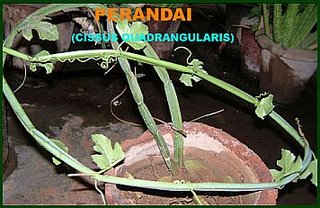
Perandai [Cissus quadrangularis]
Perandai is an indigenous medicinal plant of India found in great quantities all around Arunachala. The use of this plant (by common folk) for promoting fracture healing is an old practice. It has been prescribed in ancient Ayurvedic texts by Bhava Prakash and Chakra Dutta as a general tonic especially for the fracture patient.
It contains high amount of vitamin C, carotene A, anabolic steroidal substances and calcium. These anabolic steroidal principles promote fracture-healing by influencing early regeneration of all connective tissues. In clinical trials Perandai has been found to cause reduction in the healing time of fractures by 55-33%. It is shown to neutralize the anti-anabolic effect of steroids like cortisone in healing of fractures.
Postmenopausal women are at particular risk to osteoporosis because the loss of estrogen associated with menopause leads to bone loss. Perandai (cissus quadrangularis) is likely to exert beneficial effects on recovery of bone mineral density in postmenopausal osteoporosis.
The stem of perandai is recommended in Ayurveda for the treatment of irregular menstruation, asthma, as an analgesic in eye and ear diseases and for complaints of the back and spine. Scientific studies have revealed perandai extract to possess cardiotonic and androgenic property.
It will improve appetite, remove constipation, kill stomach worms, cure piles and is also act effective for loose motion, or dysentry.
The quantity regarded as optimum by herbologists is a gramme. In Tamil homes perandai is often taken with clarified butter or in the form of a tasty chutney.
Chutney: Tender perandai add tamarind, chillies, cumin seeds and ghee, salt, fresh garlic and onion and grind till smooth. Very tasty as a condiment eaten with rice.
Perandai is an indigenous medicinal plant of India found in great quantities all around Arunachala. The use of this plant (by common folk) for promoting fracture healing is an old practice. It has been prescribed in ancient Ayurvedic texts by Bhava Prakash and Chakra Dutta as a general tonic especially for the fracture patient.
It contains high amount of vitamin C, carotene A, anabolic steroidal substances and calcium. These anabolic steroidal principles promote fracture-healing by influencing early regeneration of all connective tissues. In clinical trials Perandai has been found to cause reduction in the healing time of fractures by 55-33%. It is shown to neutralize the anti-anabolic effect of steroids like cortisone in healing of fractures.
Postmenopausal women are at particular risk to osteoporosis because the loss of estrogen associated with menopause leads to bone loss. Perandai (cissus quadrangularis) is likely to exert beneficial effects on recovery of bone mineral density in postmenopausal osteoporosis.
The stem of perandai is recommended in Ayurveda for the treatment of irregular menstruation, asthma, as an analgesic in eye and ear diseases and for complaints of the back and spine. Scientific studies have revealed perandai extract to possess cardiotonic and androgenic property.
It will improve appetite, remove constipation, kill stomach worms, cure piles and is also act effective for loose motion, or dysentry.
The quantity regarded as optimum by herbologists is a gramme. In Tamil homes perandai is often taken with clarified butter or in the form of a tasty chutney.
Chutney: Tender perandai add tamarind, chillies, cumin seeds and ghee, salt, fresh garlic and onion and grind till smooth. Very tasty as a condiment eaten with rice.
2 comments:
This looks like exactly the plant that was hidden amongst the jasmine crawlers, while I was living in SA-13 in Prasanthi Nilayam. Venkamma would instruct me to break off some and bring it in, when people would come to her for various ailments, and she would prepare medicines with other ingredients like tamarind, turmeric and sunna (the white-wash white lime paste). When people asked what it was, she would sneakily tell them she had hidden it within other plants, and it was a secret.
It grows very quickly. I once brought a small piece of it from my walk around Arunachala and planted it when I got home - it grew like it was something out of HG Wells. Wow!
Ramana Maharshi used to prepare it as a condiment when he used to work in the kitchen at his Ashram.
I was told that the Ashram still prepares this and other edibile herbs and plants from around Arunachala - and includes them with meals.
Post a Comment